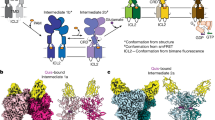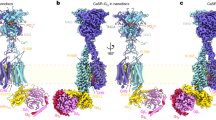Abstract
INOSITOL 1,4,5-trisphosphate (Ins (1,4,5)P3), a second messenger molecule involved in actions of neurotransmitters, hormones and growth factors, releases calcium from vesicular non-mitochondrial intracellular stores1 An Ins(l,4,5)P3 binding protein, purified from brain membranes2, has been shown to be phosphorylated by cyclic-AMP-dependent protein kinase3 and localized by immunohistochemical techniques to intracellular particles associated with the endoplasmic reticulum4. Although the specificity of the Ins(l,4,5)P3 binding protein for inositol phosphates and the high affinity of the protein for Ins(l,4,5)P3 indicate that it is a physiological Ins(l,4,5)P3 receptor mediating calcium release, direct evidence for this has been difficult to obtain. Also, it is unclear whether a single protein mediates both the recognition of Ins(l,4,5)P3 and calcium transport or whether these two functions involve two or more distinct proteins. In the present study we report reconstitution of the purified Ins(l,4,5)P3 binding protein into lipid vesicles. We show that Ins(l,4,5)P3 and other inositol phosphates stimulate calcium flux in the reconstituted vesicles with potencies and specificities that match the calcium releasing actions of Ins(l,4,5)P3. These results indicate that the purified Ins(l,4,5)P3 binding protein is a physiological receptor responsible for calcium release.
This is a preview of subscription content, access via your institution
Access options
Subscribe to this journal
Receive 51 print issues and online access
$199.00 per year
only $3.90 per issue
Buy this article
- Purchase on Springer Link
- Instant access to full article PDF
Prices may be subject to local taxes which are calculated during checkout
Similar content being viewed by others
References
Berridge, M. J. A. Rev. Biochem. 56, 159–193 (1987).
Supattapone, S., Worley, P. F., Baraban, J. M. & Snyder, S. H. J. biol. Chem. 263, 1530–1534 (1988).
Supattapone, S. et al. Proc. natn. Acad. Sci. U.S.A. 85, 8747–8750 (1988).
Ross, C. A. et al. Nature 339, 468–470 (1989).
Jones, O. T., Earnest, J. P. & McNamee, M. G. in Biological Membranes: A Practical Approach (eds Findlay, J. B. C. & Evans, W. H. (IPL, Oxford, 1987).
Huganir, R. & Racker, E. J. biol. Chem. 257, 9372–9378 (1982).
Worley, P. F. et al. J. biol. Chem. 262, 12132–12136 (1987).
Hill, T., Berggren P. O. & Boynton, A. Biochem. biophys. Res. Commun. 149, 897–901 (1987).
Cullen, P. J., Comerford, J. G. & Dawson, A. P. FEBS Lett. 228, 57–59 (1988).
Nilsson, T., Zwiller, J., Boynton, A. L. & Berggren, P. O. FEBS Lett. 229, 211–214 (1988).
Joseph, S. K. & Rice, H. L. Molec. Pharm. 35, 355–359 (1989).
Ghosh, T. K. et al. J. biol. Chem. 263, 11075–11079 (1988).
Guillemette, G., Lamontagne, S., Boulay, G. & Mouillac, B. Molec. Pharm. 35, 339–344 (1989).
Ghosh, T. K., Mullaney, M. M., Tarazi, F. I. & Gill, D. L. Nature 340, 236–239 (1989).
Irvine, R. F. Biochem. Soc. Trans. 17, 6–9 (1989).
Nahorski, S. R. Trends pharm. Sci. 10, 139–144 (1989).
Barnard, E. A., Darlison, M. G. & Seeburg, P. Trends Neurosci. 10, 502–509 (1987).
Inui, M., Saito, A. & Fleischer, S. J. biol. Chem. 262, 1740–1747 (1987).
Lai, G. A., Erickson, H. P., Roussear, D., Liu, Q-Y. & Meissner, G. Nature 331, 315–319 (1988).
Imagana, T., Smith, J. S., Coronado, R. & Campbell, K. P. J. biol. Chem. 262, 16636–16643 (1987).
Takeshima, H. et al. Nature 339, 439–445 (1989).
Bradford, M. M. Analyt. Biochem. 72, 248–254 (1976).
Laemmli, U. K. Nature 227, 680–685 (1970).
Author information
Authors and Affiliations
Rights and permissions
About this article
Cite this article
Ferris, C., Huganir, R., Supattapone, S. et al. Purified inositol 1,4,5-trisphosphate receptor mediates calcium flux in reconstituted lipid vesicles. Nature 342, 87–89 (1989). https://doi.org/10.1038/342087a0
Received:
Accepted:
Issue Date:
DOI: https://doi.org/10.1038/342087a0
This article is cited by
-
KRAP tethers IP3 receptors to actin and licenses them to evoke cytosolic Ca2+ signals
Nature Communications (2021)
-
Regulation of osteoclasts by membrane-derived lipid mediators
Cellular and Molecular Life Sciences (2013)
-
Transport of receptors, receptor signaling complexes and ion channels via neuropeptide-secretory vesicles
Cell Research (2011)
Comments
By submitting a comment you agree to abide by our Terms and Community Guidelines. If you find something abusive or that does not comply with our terms or guidelines please flag it as inappropriate.



